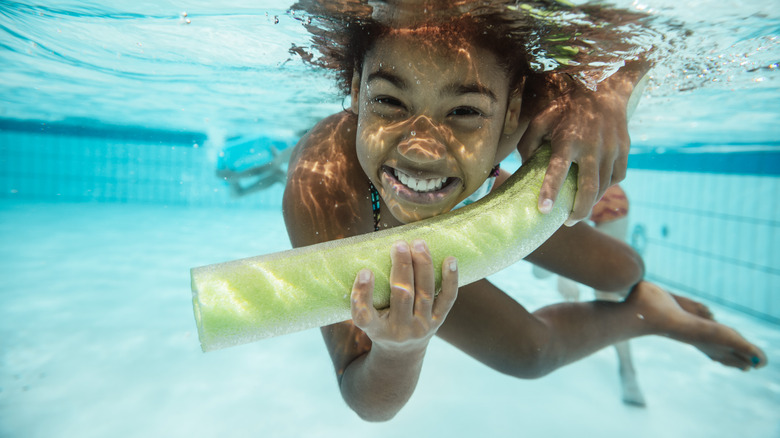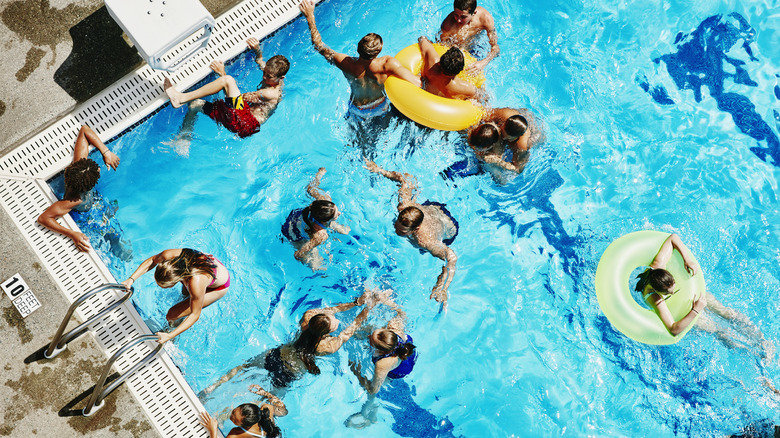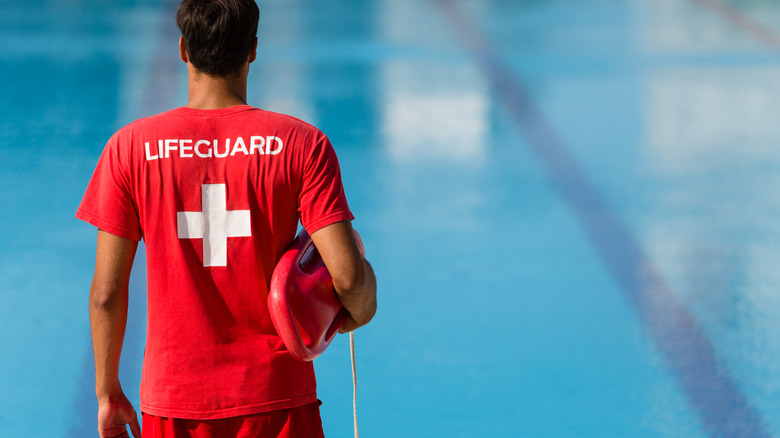Avoid Swimming In A Public Pool That Has Any Of These Major Red Flags
For most families, hitting up a public swimming pool is a great way to beat the hot weather and enjoy a fun day out away from home. After all, these typically family-friendly and affordable facilities don't just ensure that the kids can get a healthy dose of exercise and vitamin D at the same time — they also let summer-weary parents soak up their own sunshine-fueled break by the water.
That said, swimming pools aren't without their own set of risks. According to the Centers for Disease Control and Prevention, over 4,000 fatal drownings are reported every year in the United States, with children ages 5 through 14 as the most vulnerable victims. Thankfully, though, helpful tips like knowing which bathing suit colors are considered the most dangerous for children to wear, learning basic water safety skills, and always having a dedicated water watcher are all great ways to enjoy pretty much any swim out there. However, beyond these common water safety practices, several other factors can also impact how and when you swim without risk.
To help you stay safe while enjoying public pools, Explore spoke with Jimmie Meece, President of America's Swimming Pool Company, to understand exactly what warning signs to look out for that a pool might be unsafe. With years of industry experience, Meece emphasized that swimmer safety depends on a combination of both pool maintenance standards and personal awareness. "Public pool safety is a shared responsibility", Meece explains. "Regular maintenance, proper chemical balance, and adherence to safety protocols are [also] crucial for ensuring a safe swimming environment".
Other signs to look out for while swimming in a public pool
One of the most important things to look out for while visiting a public pool is the water quality and the surrounding environment. "Cloudy or discolored water can indicate poor water quality and inadequate filtration, which may pose health risks", warns Meece. In most cases, this murky appearance usually signals that there's bacterial growth present, or that the pool hasn't been properly chemically treated and cleaned. Other visual cues that something might be wrong include any visible debris or algae floating around, and any damaged or missing tiles that might lead to accidents, cuts, and injuries.
Along with these red flags, another major sign that something might be wrong is the presence of a strong chemical smell. Contrary to popular belief, a heavy chlorine smell typically indicates a problem rather than excessive cleanliness –– so don't just assume a pool is extra clean because it smells like chlorine! "A strong chlorine odor can be a sign of improper chemical balance, which can irritate skin and eyes", Meece points out.
If you do happen to see (or smell) any of these issues during your visit, the best thing to do is to take immediate action. "Flag down a lifeguard", advises Meece. "Lifeguards are trained to handle safety concerns and can take immediate action to address the issue". If you can't find one available at the moment, look for the pool manager and let them know.
How to enjoy a public pool experience safely
Despite the potential risks, there's no need to completely write off public pools this summer. Beyond keeping an eye out for any warning signs, there are several other personal precautions you can take to ensure that you and your family swim safely and stay healthy. One of the best ways to do this? "Wear a bathing cap", says Meece. "This helps keep hair out of the water and reduces the spread of contaminants".
Aside from keeping your hair all wrapped up, your pre-swim routine also matters when it comes to preventing illness. Per Meece's suggestions, make sure you always shower before and after swimming. "This helps remove sweat, dirt, and bacteria from your body, reducing the risk of waterborne illnesses". Additionally, he also recommends that you avoid getting in the water with any open cuts or wounds, since this can lead to serious infections that, at the same time, can easily spread through the communal water.
Lastly, staying safe around a pool also has to do with one very important factor: always following pool capacity rules. "Overcrowding can lead to decreased water quality and increased risk of accidents", says Meece. If you feel the pool has too many swimmers, it's best to sit it out and wait for the crowds to die down a little bit before having your own go. At the end of the day, pool rules are put in place for a reason, and refusing to follow them only means putting yourself and others at risk.


